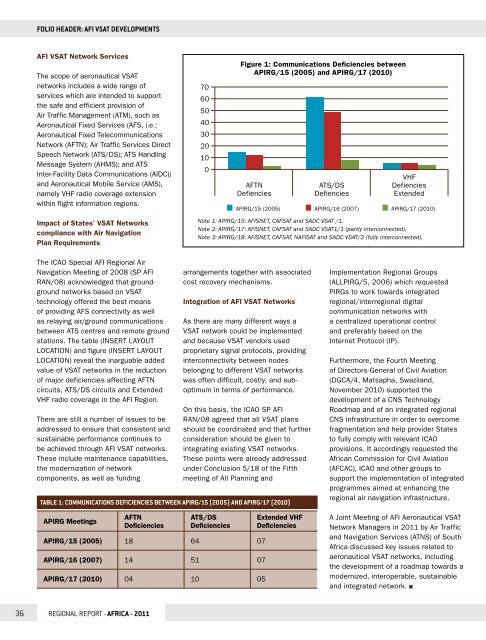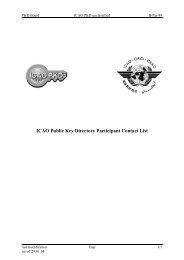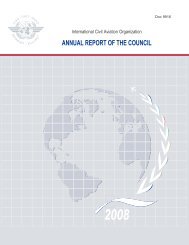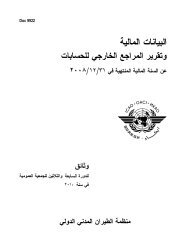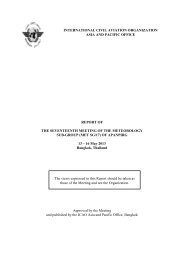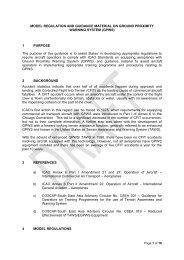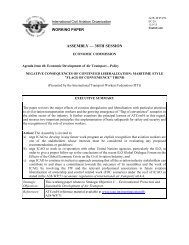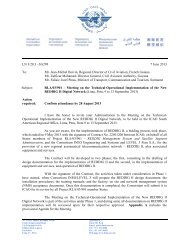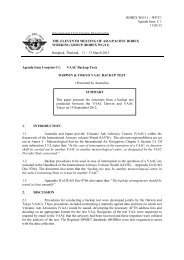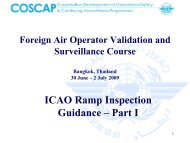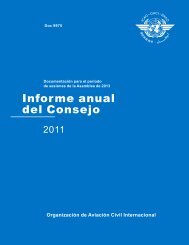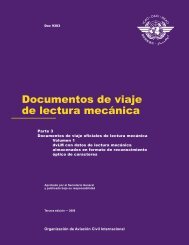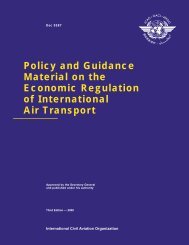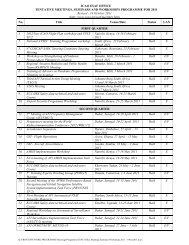Joint Western & Central African (WACAF) Office and - ICAO
Joint Western & Central African (WACAF) Office and - ICAO
Joint Western & Central African (WACAF) Office and - ICAO
Create successful ePaper yourself
Turn your PDF publications into a flip-book with our unique Google optimized e-Paper software.
FOLIO HEADER: AFI VSAT DEVELOPMENTS<br />
AFI VSAT Network Services<br />
The scope of aeronautical VSAT<br />
networks includes a wide range of<br />
services which are intended to support<br />
the safe <strong>and</strong> efficient provision of<br />
Air Traffic Management (ATM), such as<br />
Aeronautical Fixed Services (AFS, i.e.:<br />
Aeronautical Fixed Telecommunications<br />
Network (AFTN); Air Traffic Services Direct<br />
Speech Network (ATS/DS); ATS H<strong>and</strong>ling<br />
Message System (AHMS); <strong>and</strong> ATS<br />
Inter-Facility Data Communications (AIDC))<br />
<strong>and</strong> Aeronautical Mobile Service (AMS),<br />
namely VHF radio coverage extension<br />
within flight information regions.<br />
Impact of States’ VSAT Networks<br />
compliance with Air Navigation<br />
Plan Requirements<br />
The <strong>ICAO</strong> Special AFI Regional Air<br />
Navigation Meeting of 2008 (SP AFI<br />
RAN/08) acknowledged that groundground<br />
networks based on VSAT<br />
technology offered the best means<br />
of providing AFS connectivity as well<br />
as relaying air/ground communications<br />
between ATS centres <strong>and</strong> remote ground<br />
stations. The table (INSERT LAYOUT<br />
LOCATION) <strong>and</strong> figure (INSERT LAYOUT<br />
LOCATION) reveal the inarguable added<br />
value of VSAT networks in the reduction<br />
of major deficiencies affecting AFTN<br />
circuits, ATS/DS circuits <strong>and</strong> Extended<br />
VHF radio coverage in the AFI Region.<br />
There are still a number of issues to be<br />
addressed to ensure that consistent <strong>and</strong><br />
sustainable performance continues to<br />
be achieved through AFI VSAT networks.<br />
These include maintenance capabilities,<br />
the modernization of network<br />
components, as well as funding<br />
36 REGIONAL REpORt - AFRICA - 2011<br />
arrangements together with associated<br />
cost recovery mechanisms.<br />
Integration of AFI VSAT Networks<br />
As there are many different ways a<br />
VSAT network could be implemented<br />
<strong>and</strong> because VSAT vendors used<br />
proprietary signal protocols, providing<br />
interconnectivity between nodes<br />
belonging to different VSAT networks<br />
was often difficult, costly, <strong>and</strong> suboptimum<br />
in terms of performance.<br />
On this basis, the <strong>ICAO</strong> SP AFI<br />
RAN/08 agreed that all VSAT plans<br />
should be coordinated <strong>and</strong> that further<br />
consideration should be given to<br />
integrating existing VSAT networks.<br />
These points were already addressed<br />
under Conclusion 5/18 of the Fifth<br />
meeting of All Planning <strong>and</strong><br />
TABLE 1: COMMuNICATIONS DEFICIENCIES BETWEEN APIRG/15 (2005) AND APIRG/17 (2010)<br />
APIRG Meetings<br />
AFTN<br />
Deficiencies<br />
70<br />
60<br />
50<br />
40<br />
30<br />
20<br />
10<br />
0<br />
ATS/DS<br />
Deficiencies<br />
APIRG/15 (2005) 18 64 07<br />
APIRG/16 (2007) 14 51 07<br />
APIRG/17 (2010) 04 10 05<br />
Figure 1: Communications Deficiencies between<br />
APIRG/15 (2005) <strong>and</strong> APIRG/17 (2010)<br />
AFTN<br />
Defiencies<br />
Extended VHF<br />
Deficiencies<br />
ATS/DS<br />
Defiencies<br />
VHF<br />
Defiencies<br />
Extended<br />
APIRG/15 (2005) APIRG/16 (2007) APIRG/17 (2010)<br />
Note 1: APIRG/15: AFISNET, CAFSAT <strong>and</strong> SADC VSAT /1.<br />
Note 2: APIRG/17: AFISNET, CAFSAT <strong>and</strong> SADC VSAT1/1 (partly interconnected).<br />
Note 3: APIRG/18: AFISNET, CAFSAT, NAFISAT <strong>and</strong> SADC VSAT/2 (fully interconnected).<br />
Implementation Regional Groups<br />
(ALLPIRG/5, 2006) which requested<br />
PIRGs to work towards integrated<br />
regional/interregional digital<br />
communication networks with<br />
a centralized operational control<br />
<strong>and</strong> preferably based on the<br />
Internet Protocol (IP).<br />
Furthermore, the Fourth Meeting<br />
of Directors-General of Civil Aviation<br />
(DGCA/4, Matsapha, Swazil<strong>and</strong>,<br />
November 2010) supported the<br />
development of a CNS Technology<br />
Roadmap <strong>and</strong> of an integrated regional<br />
CNS infrastructure in order to overcome<br />
fragmentation <strong>and</strong> help provider States<br />
to fully comply with relevant <strong>ICAO</strong><br />
provisions. It accordingly requested the<br />
<strong>African</strong> Commission for Civil Aviation<br />
(AFCAC), <strong>ICAO</strong> <strong>and</strong> other groups to<br />
support the implementation of integrated<br />
programmes aimed at enhancing the<br />
regional air navigation infrastructure.<br />
A <strong>Joint</strong> Meeting of AFI Aeronautical VSAT<br />
Network Managers in 2011 by Air Traffic<br />
<strong>and</strong> Navigation Services (ATNS) of South<br />
Africa discussed key issues related to<br />
aeronautical VSAT networks, including<br />
the development of a roadmap towards a<br />
modernized, interoperable, sustainable<br />
<strong>and</strong> integrated network.


